Why 3D Printing?
Additive manufacturing, often known as 3D printing is a process which is used to manufacture parts by the way of binding material layer by layer. Unlike subtractive manufacturing this technology is based on adding material layer by layer.
Widely used across variegated industries like aerospace, defense, automotive, consumer products, medical and the like, this technology has experienced exponential growth in its user base in a shot span of time.
These applications include testing prototypes, fit and assembly models, casting, presentation models, visual aids, and tooling components.
Having stated this let us see why and how additive manufacturing is important in the rapid prototyping and manufacturing industry?
How did the manufacturing industry function before the advent of 3D Printing? For this purpose, let’s cite a hypothetical example- Considering factors like amount of process planning, setup, downtime and operating time for 3D printer and subtractive manufacturing, one can consider the mass production of the famous Eiffel Tower miniature by way of using subtractive (/traditional) manufacturing setup. For this purpose, X time and 2.0 units material has to be utilized. Juxtaposing this scenario with an additive manufacturing setup would result in X/3 time and 1.3 unit material (and, shades).
The following image is a representation of this apparent contrast-
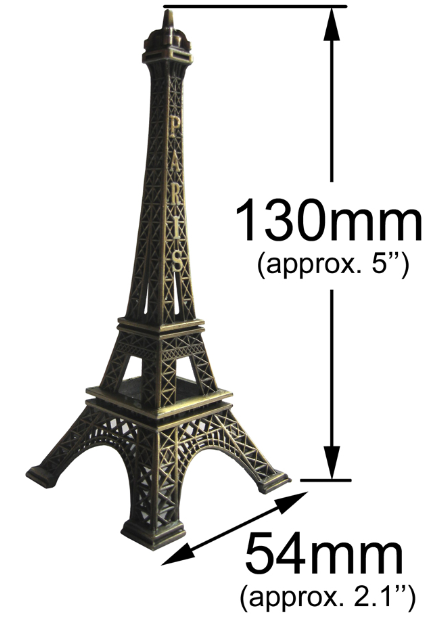 | 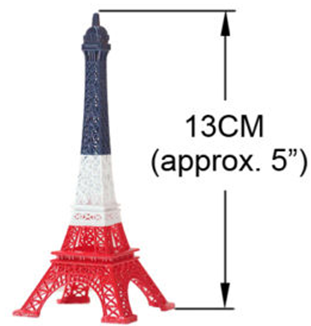 |
Figure 1: Example of Eiffel tower miniature
Defining moment of manufacturing industry
Given this flexibility and benefit, the additive process soon gained momentum in the manufacturing industry. All in all, 3D Printing promises optimized utilization of time in the course of delivering effective material and cost in pursuit of the final product. Eiffel Tower miniature is one of many such examples which in an attempt to translate into reality would either fail (or, pose to be extremely difficult) in the absence of 3D Printing. The bottom line always remains constant- how easy it is manufacture a model with multiple faces and surfaces, all at different angles with overhangs and undercuts? If it’s moderately easy, does it even assure the achievement of the final goal-production?
All this is only possible if one finds a way to support the overhanging material in some manner. 3D Printing is a process which gives larger scope of converting complex ideas into reality.
“This process gives a larger scope of converting complex Ideas into Reality”
The Era of Reaping Benefits
Simplifying Complexity:
- 3D Printing breathes life into innovative and creative designs. It enables CAD Engineers and Product Specialists to perform multiple iterations without adding to costs associated with traditional manufacturing methods.
- New additive manufacturing processes make it possible to produce parts that were once considered extremely difficult to produce by way of using traditional manufacturing technologies.
Material Saving Process:
- Additive Manufacturing differs from machining (subtractive manufacturing) where material (scrap) is removed to get the final product.
- Additive manufacturing minimizes scrap generation and down time during the process.
Weight Reduction
- 3D Printing systems either extrude melt or even sinter material producing complex structures with higher strength-to-weight ratio as compared to complete solid structures. This results in significant weight reduction and improved part performance.
- 3D Printing lets one reap the above mentioned benefits, but does it guarantee things falling into right place at all times? Are there guidelines which on being followed boost the manufacturing process?
The A to Z of 3D Printing
In the real world, the answer is YES. Guidelines of 3D Printing may vary from manufacturing processes, but the fundamentals remain fixed paving an easy route to the desired output. Typically, these guidelines can be found in Additive Manufacturing handbooks, documents et al referring to which may become tedious if one is looking for specific guideline(s). Having a software solution to assist in making design suitable for 3D Printing would simplify the process.
DFMPro is one such solution, integrated within popular CAD platforms which enables Design/Manufacturing Engineers to get the right designs confirming to the recommended guidelines for manufacturing processes like 3D Printing, Injection Molding, Assembly, Sheet Metal, Casting and many more.
Let’s have a look on some of the Additive manufacturing guidelines available in DFMPro.
Typical Guidelines for Additive Manufacturing Processes like FDM, SLA, 3DP
Faces requiring support:
Support structures also known as scaffolding is the material created to support the object during printing. This is similar to building a bridge over water which requires the optimum use of such supports. This requires different methods for printing models depending on the material or technology applied. All 3D Printers work on the fundamental principle of adding layer on layer but some techniques are more efficient than others. FDM (Fused Deposition Method) uses a thermoplastic material (like ABS) and heat to print the model. However, it requires support structures to be created with the model to support any overhangs or undercuts.
Normally supports are needed in such 3D printing process if 3D model has an overhang of 45 degrees or more. The angle is determined by several factors like material, layer height and extrusion width. It becomes critical to adjust the support structures accordingly to ensure the best print result, especially for large format 3D prints. This also becomes time consuming task with results that might be ineffective and may lead to result in an unsatisfactory experience.
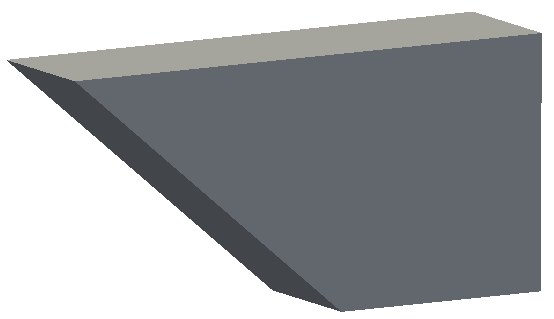 | 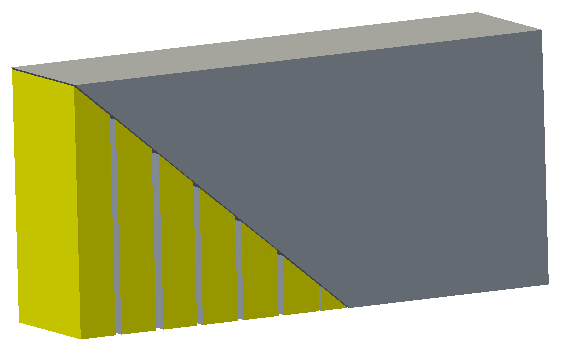 |
Figure-2: Support is needed for overhang of more than 45 degree

Figure-3: Model for faces requiring support
*DFMPro helps to quickly detect faces of the part requiring support.

Figure-4: Highlighted instance and recommendation for faces requiring support
Thickness between Faces
Typically, problems associated with wall thickness are by far the most common reasons why some 3D models are not printable. In some cases, the wall thickness or thickness between faces are too thin. Walls that are too thin make it impossible to print the parts or they turn out to be very fragile and could often break easily. In other cases, walls / faces that are too thick generate too much internal stress and can cause the item to crack or even break.
*DFMPro can help to confirm design for the required minimum thickness between faces/walls for additive manufacturing.

Figure-5: Highlighted instances for thickness between faces
In the above image instances with small thickness have been highlighted. Below are the DFMPro recommendations for such case(s).
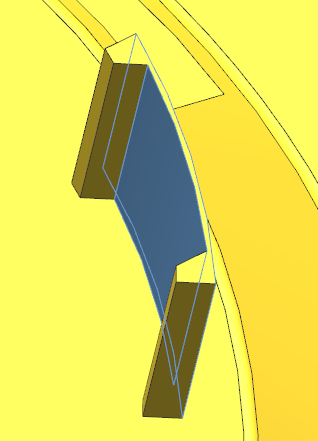 | 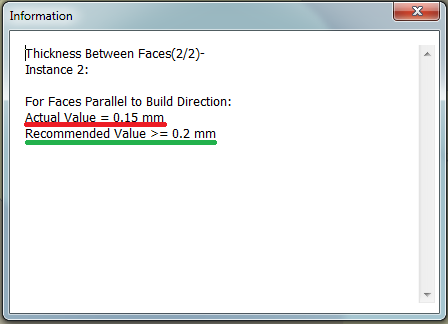 |
Figure-6: Recommendation as per configuration
Maximum Hole Size
Circular holes when perpendicular to build direction are easy to manufacture in additive manufacturing if they are small in size. Similarly aligned but large holes result in rough surface on the upper region that may need machining.
Consider the circular holes, as shown in the picture, for a part being printed along the z axis. One has to take care of various dimensional aspects. The image shows three holes of 3 mm, 5 mm and 9 mm diameters respectively from left to right.
Plastic has some rigidity, so we can print the 3mm hole fine. The 5mm hole may have some drooping plastic, and would need to be drilled out. The 9 mm highlighted hole would likely print rough and requires much post processing to achieve better finish.

Figure-7: Example Model
At the CAD modeling level, the holes appear to fine. The issue can normally be captured in the 3D printing software or after manufacturing the part.

Figure 8: Additive Manufacturing guidelines in DFMPro
*DFMPro predicts such cases at an early design stage to avoid such additive manufacturing issues.

Figure-9: Highlighted instances for maximum hole size
As per maximum hole size guidelines, below is the instance highlighted as failure with DFMPro recommendations.
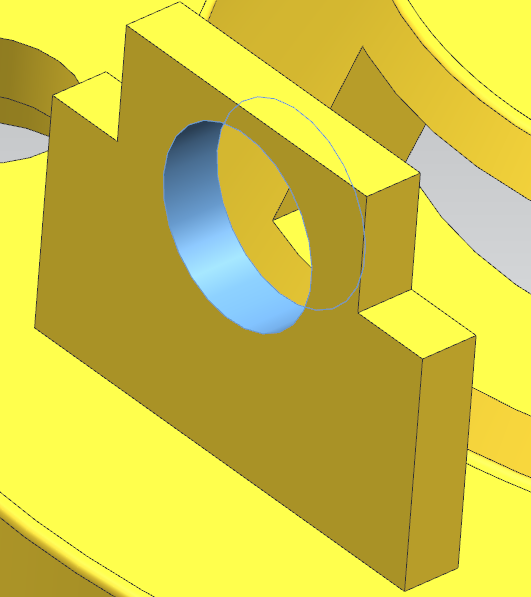 | 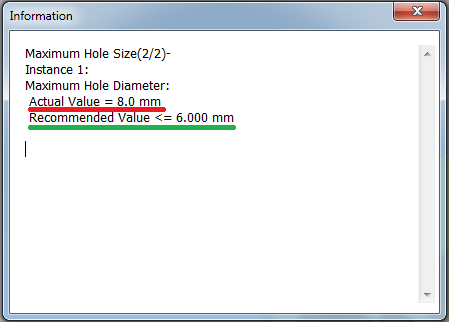 |
Figure-10: Recommendation for maximum hole size
With help of such design guidelines we can minimize design iterations and introduce them as fit for manufacturing by saving time and cost.
There are currently world changing applications for 3D printers being developed for the future. Such developments like DFMPro include design for manufacturing techniques and are being used as a solution which could serve the purpose of innovation and betterment of standard practices.
References: